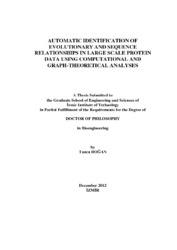Please use this identifier to cite or link to this item:
https://hdl.handle.net/11147/2944Full metadata record
| DC Field | Value | Language |
|---|---|---|
| dc.contributor.advisor | Karaçalı, Bilge | - |
| dc.contributor.author | Doğan, Tunca | - |
| dc.date.accessioned | 2014-07-22T13:48:38Z | - |
| dc.date.available | 2014-07-22T13:48:38Z | - |
| dc.date.issued | 2012 | - |
| dc.identifier.uri | http://hdl.handle.net/11147/2944 | - |
| dc.description | Thesis (Doctoral)--İzmir Institute of Technology, Biotechnology and Bioengineering, İzmir, 2012 | en_US |
| dc.description | Includes bibliographical references (leaves: 111-115) | en_US |
| dc.description | Text in English; Abstract: Turkish and English | en_US |
| dc.description | xii, 115 leaves | en_US |
| dc.description.abstract | In this study, computational methods are developed for the automatic identification of functional/evolutionary relationships between biomolecular sequences in large and diverse datasets. Different approaches were considered during the development and optimization of the methods. The first approach focused on the expression of gene and protein sequences in high dimensional vector spaces via non-linear embedding. This allowed statistical learning algorithms to be applied on the resulting embeddings in order to cluster and/or classify the sequences. The second approach revised the pairwise similarities between sequences following multiple sequence alignment in order to eliminate the unreliable connections due to remote homology and/or poor alignment. This is achieved by thresholding the pairwise connectivity map over 2 parameters: the inferred evolutionary distances and the number of gapless positions in each pairwise alignment. The resulting connectivity map was disjoint and consisted of clusters of similar proteins. The third and the final approach sought to associate the amino acid sequences with each other over highly conserved/shared sequence segments, as shared sequence segments imply conserved functional or structural attributes. An automated method was developed to identify these segments in large and diverse collections of amino acid sequences, using a combination of sequence alignment, residue conservation scoring and graph-theoretical approaches. The method produces a table of associations between the input sequences and the identified conserved regions that can reveal both new members to the known protein families and entirely new lines. The methods were applied to a dataset composed of 17793 human proteins sequences in order to obtain a global functional relation map. On this map, functional and evolutionary properties of human proteins could be found based on their relationships to the ones bearing functional annotations. The results revealed that conserved regions corresponded strongly to annotated structural domains. This suggests the method can also be useful in identifying novel domains on protein sequences. | en_US |
| dc.language.iso | en | en_US |
| dc.publisher | Izmir Institute of Technology | en_US |
| dc.rights | info:eu-repo/semantics/openAccess | en_US |
| dc.subject.lcsh | Bioinformatics | en |
| dc.subject.lcsh | Computational biology | en |
| dc.title | Automatic Identification of Evolutionary and Sequence Relationships in Large Scale Protein Data Using Computational and Graph-Theoretical Analyses | en_US |
| dc.type | Doctoral Thesis | en_US |
| dc.department | Thesis (Doctoral)--İzmir Institute of Technology, Bioengineering | en_US |
| dc.relation.publicationcategory | Tez | en_US |
| dc.identifier.wosquality | N/A | - |
| dc.identifier.scopusquality | N/A | - |
| item.openairecristype | http://purl.org/coar/resource_type/c_18cf | - |
| item.cerifentitytype | Publications | - |
| item.fulltext | With Fulltext | - |
| item.languageiso639-1 | en | - |
| item.grantfulltext | open | - |
| item.openairetype | Doctoral Thesis | - |
| Appears in Collections: | Phd Degree / Doktora | |
Files in This Item:
| File | Description | Size | Format | |
|---|---|---|---|---|
| T001090.pdf | DoctoralThesis | 3.26 MB | Adobe PDF |  View/Open |
CORE Recommender
Page view(s)
260
checked on Apr 28, 2025
Download(s)
134
checked on Apr 28, 2025
Google ScholarTM
Check
Items in GCRIS Repository are protected by copyright, with all rights reserved, unless otherwise indicated.